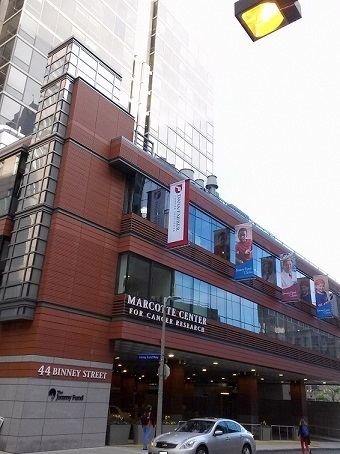Care system Private Number of beds 27 | ||
 | ||
Hospital type Teaching and Specialist Address 450 Brookline Ave, Boston, MA 02215, USA Hours Closed now Wednesday8:30AM–5PMThursday8:30AM–5PMFriday8:30AM–5PMSaturdayClosedSundayClosedMonday8:30AM–5PMTuesday8:30AM–5PM Similar Pulsipher Michael A MD, Dana Farber Cancer Inst, Boston Medical Center, Jennifer Chan - MD - MPH Profiles | ||
Dana–Farber Cancer Institute is a comprehensive cancer treatment and research center in Boston, Massachusetts. It is a principal teaching affiliate of Harvard Medical School, and a founding member of Dana–Farber/Harvard Cancer Center, a Comprehensive Cancer Center designated by the National Cancer Institute.
Contents
Overview
Dana-Farber employs more than 4,274 full-time and part-time people, 467 faculty, and has annual gross revenues of about $1,086,638,000. There are more than 299,202 adult and pediatric patient visits a year, and it is involved in more than 700 clinical trials. It is internationally known for its research and clinical excellence. Expertscape ranks its programs in aplastic anemia and multiple myeloma as best in the world. It has been also ranked the fourth best cancer hospital in the United States by U.S. News & World Report. Dana-Farber is a member of the Multiple Myeloma Research Consortium.
In addition to being a principal teaching affiliate of Harvard Medical School, Dana-Farber is also a federally designated Center for AIDS Research, and a founding member of the Dana-Farber/Harvard Cancer Center (DF/HCC), a federally designated Comprehensive Cancer Center. Providing advanced training in cancer treatment and research for an international faculty, Dana-Farber conducts community-based programs in cancer prevention, detection, and control in New England, and maintains joint programs with other Boston institutions, including Brigham and Women's Hospital, Boston Children's Hospital, and Massachusetts General Hospital.
Dana-Farber is supported by the National Cancer Institute, the National Institute of Allergy and Infectious Diseases, and private foundations and individuals contributions. The Jimmy Fund is the principal charity of the Institute named for one of its child patients. The Boston Red Sox adopted the Jimmy Fund as its official charity in 1953 and continues to prominently sponsor the charity.
Laurie H. Glimcher, MD is President / CEO of Dana–Farber Cancer Institute/Jimmy Fund. In 2015, Forbes listed the charity as the 37th biggest in the U.S.
History
1947 - Sidney Farber, MD, founded the Children's Cancer Research Foundation.
1969 - The Institute officially expanded its programs to include patients of all ages.
1974 - It became known as the Sidney Farber Cancer Institute in honor of its founder.
1983 - The support of the Charles A. Dana Foundation was acknowledged by incorporating Dana's name.
Breakthroughs
Dana-Farber has a long history of breakthrough discoveries in cancer care and research.
Patient care
Dana-Farber/Brigham and Women's Cancer Center (DF/BWCC) is a collaboration between Dana–Farber Cancer Institute and Brigham and Women's Hospital to care for adults with cancer. Dana-Farber provides outpatient services, while inpatient care is provided by Brigham and Women's Hospital. DF/BWCC cares for adult patients in more than a dozen specialized treatment centers. This coordinated arrangement makes it possible for many people to see all of their specialists in a single visit.
Boston Children's Cancer and Blood Disorders Center is a more than 60-year-old partnership between Boston Children's Hospital and Dana–Farber Cancer Institute that delivers comprehensive care to children with and survivors of all types of childhood cancers.
They also work with several other local New England organizations that share a similar vision, such as Take a Swing at Cancer, Angel's Hope, Childhood Cancer Lifeline of New Hampshire and Andrew's Helpful Hands.
